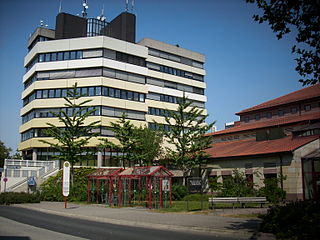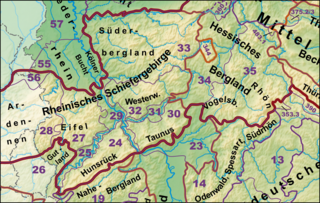


The Rhume Spring (German : Rhumequelle) is a large karst spring in the eastern part of the Rotenberg ridge not far from the northeastern edge of the village of Rhumspringe in the Harz mountains of Germany. It is the source of the River Rhume.



The Rhume Spring (German : Rhumequelle) is a large karst spring in the eastern part of the Rotenberg ridge not far from the northeastern edge of the village of Rhumspringe in the Harz mountains of Germany. It is the source of the River Rhume.
The spring is easily accessible by a nearby road.

Northeim is a district in Lower Saxony, Germany. It is bounded by the districts of Holzminden, Hildesheim, Goslar and Göttingen, and the state of Hesse.
Sömmerda is a Kreis (district) in the north of Thuringia, Germany. Neighboring districts are the districts Kyffhäuserkreis, the Burgenlandkreis in Saxony-Anhalt, the district Weimarer Land and the district-free city Erfurt, and the districts Gotha and Unstrut-Hainich-Kreis.
Unstrut-Hainich-Kreis is a Kreis (district) in the north of Thuringia, Germany. Neighboring districts are the districts Eichsfeld, Kyffhäuserkreis, Sömmerda, Gotha, Wartburgkreis and the district Werra-Meißner in Hesse.

Westerholt Power Station was a coal fired power station in Gelsenkirchen-Westerholt, Germany. The power plant consisted of two units built in the 1960s, each capable of producing 150 MW of electricity. Its smokestack, built in 1981, was 337 metres tall, making it Germany's tallest chimney at the time.

Gieboldehausen is a municipality in the district of Göttingen, in Lower Saxony, Germany. It is situated on the river Rhume, approx. 25 km northeast of Göttingen, and 15 km south of Osterode am Harz. It is part of the Eichsfeld.

Gewandhaus is a concert hall in Leipzig, the home of the Leipzig Gewandhaus Orchestra. Today's hall is the third to bear this name; like the second, it is noted for its fine acoustics.

Advanced landing grounds (ALGs) were temporary advance airfields constructed by the Allies during World War II during the liberation of Europe. They were built in the UK prior to the invasion and thereafter in northwest Europe from 6 June 1944 to V-E Day, 7 May 1945.

Rhumspringe is a municipality in the district of Göttingen, in Lower Saxony, Germany. It is part of the Eichsfeld. The source of the river Rhume is at Rhume Spring in Rhumspringe.
Harz is a district in Saxony-Anhalt, Germany. Its area is 2,104.9 km2 (812.7 sq mi).

The Rhenish Massif, Rhine Massif or Rhenish Uplands is a geologic massif in western Germany, eastern Belgium, Luxembourg and northeastern France. It is drained centrally, south to north by the river Rhine and a few of its tributaries.

The Rhume is a 48 km (30 mi) long river in Lower Saxony, Germany. It is a right tributary of the Leine. Its source is the karstic spring of Rhume Spring in Rhumspringe, south of the Harz mountain range. The water drains with high pressure from the ground of the funnel-shaped well, known for its turquoise colour.

The Oder is a 56-kilometre-long (35 mi) river in Lower Saxony, Germany, and a right tributary of the Rhume. Its source is in the Harz mountains, near Sankt Andreasberg. It flows southwest through Bad Lauterberg, Pöhlde and Hattorf am Harz. The Oder flows into the Rhume in Katlenburg-Lindau.

Söse is a river of Lower Saxony, Germany. It is a right tributary of the river Rhume and 38 kilometres (24 mi) long.

Sieber is a river of Lower Saxony, Germany, in the Harz mountains. It is 35 kilometres (22 mi) long and a right hand tributary of the Oder.

The B 241 is a federal road (Bundesstraße) in Germany.

The Große Steinau is a river of Lower Saxony, Germany.

A karst spring or karstic spring is a spring that is part of a karst hydrological system.
Eller is a river of Lower Saxony and Thuringia, Germany.

Hahle is a river of Thuringia and of Lower Saxony, Germany. It joins the Rhume in Gieboldehausen.
The Eichbach, also called Eiche, is a river of Thuringia, Germany.